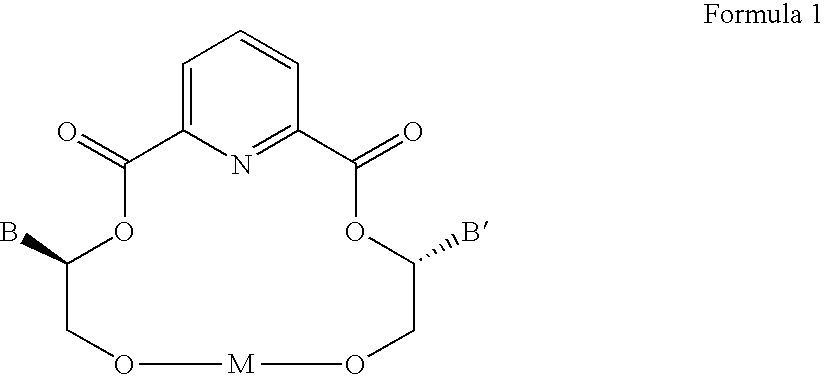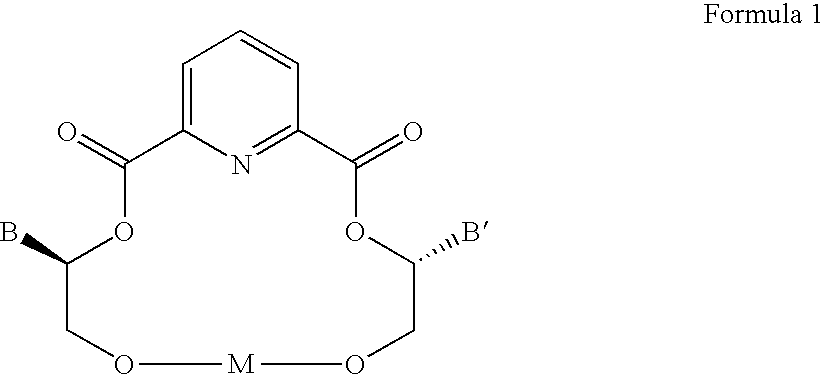Compositions and methods for separating amines and amino acids from their counter-enantiomers
- Summary
- Abstract
- Description
- Claims
- Application Information
AI Technical Summary
Benefits of technology
Problems solved by technology
Method used
Image
Examples
example 1
Preparation of di-tert-butyl-diketo-pyridine-18-crown-6 tethered to polystyrene
[0053]4S, 14S-(+)-4,14-Di-tert-butyl-3,6,9,12,15-pentaoxa-21-azabicyclo[15.3.1]heneicosa-1 (21),17,19-triene-2,16-dione attached through a side arm to polystyrene (composition 5 below) can be prepared as follows:
[0054]
[0055]In the above reaction scheme, composition 1, which is commercially available, and composition 2 are reacted by a condensation reaction process in the presence of molecular sieves and methanol. This condensation reaction forms a pyridine-18-crown-6 as shown in composition 3. The blocking group can then be removed by conventional methods to form a second pyridine-18-crown-6 as shown in composition 4. Composition 4 can then be reacted with cesium carbonate and chloromethylpolystyrene in THF to form the di-tert-butyl-diketo-pyridine-18-crown-6 bound to polystyrene shown in composition 5.
[0056]As a side note, the side arms can be different than that shown above. For example, —(CH2)nO—, —(CH...
example 2
Preparation of diphenyl-diketo-pyridine-18-crown-6 tethered to polystyrene
[0060]4S,14S-(−)-4,14,Diphenyl-3,6,9,12,15-pentaoxa-21-azabicyclo[15.3.1]heneicosa-1(21),17,19-triene-2,16-dione attached through a side arm to polystyrene (Composition 16 below) can be prepared as follows:
[0061]
[0062]In the above reaction scheme, composition 16 is prepared by, first, carrying out a condensation reaction between composition 1 and composition 18 in methanol in the presence of molecular sieves, resulting in the pyridine-18-crown-6 of composition 14. Composition 14 can then be deprotected to form composition 15 by conventional methods. Composition 15 can then be reacted with cesium carbonate and chloromethyl polystyrene in a mixture of acetonitrile and tetrahydrofuran to form composition 16.
[0063]As a side note, the side arms can be different that that shown above. For example, —(CH2)nO—, —(CH2)nN—, or —(CH2)nS—, can be used, where n is an integer from 1 to 18. Alternatively, branched alkyl-O, br...
example 3
Preparation of di-tert-butyl-diketo-pyridine-15-crown-5 tethered to polystyrene
[0067]4S,11 S-4,11-Di-tert-butyl-3,6,9,12-tetraoxa-18-azabicyclo[12.3.1]oxtadecane-(18), 14,16-triene-2,13-dione attached through a side arm to polystyrene (Composition 21 below) can be prepared as follows:
[0068]
[0069]The preparation of composition 21 above is carried by first, a condensation reaction between composition 1 and composition 17 in methanol in the presence of molecular sieves. The resulting composition is a protected pyridine-15-crown-5. The protected pyridine-15-crown-5 can be deproteced to form composition 20 by conventional methods. Composition 20 can be attached to polystyrene by reacting the composition in cesium carbonate and chloromethylpolystyrene in THF / CH3CN to form composition 21.
[0070]As a side note, the side arms can be different that that shown above. For example, —(CH2)nO—, —(CH2)nN—, or —(CH2)nS—, can be used, where n is an integer from 1 to 18. Alternatively, branched alkyl-O...
PUM
| Property | Measurement | Unit |
|---|---|---|
| Fraction | aaaaa | aaaaa |
| Fraction | aaaaa | aaaaa |
| Fraction | aaaaa | aaaaa |
Abstract
Description
Claims
Application Information
 Login to View More
Login to View More - R&D
- Intellectual Property
- Life Sciences
- Materials
- Tech Scout
- Unparalleled Data Quality
- Higher Quality Content
- 60% Fewer Hallucinations
Browse by: Latest US Patents, China's latest patents, Technical Efficacy Thesaurus, Application Domain, Technology Topic, Popular Technical Reports.
© 2025 PatSnap. All rights reserved.Legal|Privacy policy|Modern Slavery Act Transparency Statement|Sitemap|About US| Contact US: help@patsnap.com



